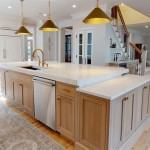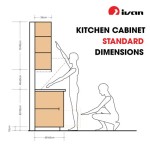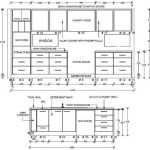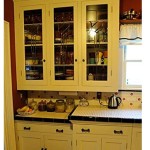What Colour To Paint A Kitchen With Grey Cupboards
The selection of a paint colour for a kitchen containing grey cupboards presents a unique set of design considerations. Grey, as a neutral, provides a versatile foundation, but its inherent properties can significantly impact the overall aesthetic of the space. The undertones of the grey, the amount of natural light available, and the desired mood all play crucial roles in determining the optimal paint colour selection. A well-considered colour palette can transform a kitchen into a stylish and inviting area, while a poorly chosen colour can make the space feel cold, sterile, or even smaller than it is.
The following article explores various colour options that complement grey cupboards, providing guidance on how to select the most suitable shade for a particular kitchen. It examines the impact of different colours on the perceived size and temperature of the room, as well as the importance of considering the existing features and personal preferences when making a final decision.
Understanding Grey Undertones
Before selecting a complementary colour, it is imperative to first identify the undertones present in the grey cupboards. Grey is not a monolithic colour; it is a composite shade that can lean towards warm or cool hues. Warm greys often contain hints of brown, beige, or even yellow, giving them a softer, more inviting feel. Cool greys, on the other hand, tend to have blue, green, or purple undertones, creating a more modern and sophisticated aesthetic. Determining the undertone of the grey is crucial because it will dictate which colours will harmonise effectively. Pairing a warm grey with a cool-toned colour can result in a clash, while matching warm greys with warm colours will create a cohesive and balanced look.
To identify the undertone, compare the grey to a pure white surface in natural light. This will help to reveal the subtle hues that are present. One can also hold colour swatches next to the grey to see which ones appear to blend seamlessly and which ones stand out in a discordant way. Online resources and colour consultants can also provide expert advice on identifying the undertones of a specific grey shade.
Once the undertone is identified, the choice of paint colour can be more precisely targeted. Warm greys lend themselves well to earthy tones, creams, and warm whites, while cool greys pair effectively with blues, greens, purples, and crisp whites. Failing to account for these undertones can lead to a kitchen design that feels disjointed and unbalanced.
Exploring Different Colour Palettes
Once the undertone of the grey has been established, various colour palettes can be explored to determine the most suitable option for the kitchen. The selection process should involve considering the desired mood, the amount of natural light available, and the size of the room. Different colours evoke different emotions, and it is important to choose a palette that reflects the desired atmosphere. Lighter colours tend to make a room feel more spacious and airy, while darker colours can create a more intimate and dramatic feel. Natural light plays a crucial role in how colours are perceived, and it is important to test paint samples in the actual kitchen to see how they look under different lighting conditions.
Here are some colour palette options that typically work well with grey cupboards:
- Crisp White: A classic choice that provides a clean and contemporary look. White effectively reflects light, making the kitchen feel brighter and more spacious. White pairs well with both warm and cool greys, but the specific shade of white should be chosen carefully to complement the grey’s undertones. For example, a warm white with creamy undertones will harmonize better with warm greys, while a cool white with bluish undertones will be more suitable for cool greys.
- Soft Greige: Greige, a blend of grey and beige, offers a sophisticated and versatile option. It provides a subtle contrast to grey cupboards, creating a calming and cohesive atmosphere. The exact shade of greige should be chosen to complement the undertone of the grey cupboards. A warmer greige will pair well with warm greys, while a cooler greige will be more suitable for cool greys.
- Pale Blue: A soft blue can add a touch of serenity and elegance to a kitchen with grey cupboards. Blue is a cool colour that works particularly well with cool greys. It can create a relaxing and inviting atmosphere, especially when paired with natural wood accents. The shade of blue should be chosen carefully to avoid overwhelming the space. A pale, muted blue is often a better choice than a brighter, more saturated blue.
- Sage Green: A muted green can bring a touch of nature into the kitchen. Sage green is a versatile colour that complements both warm and cool greys. It can create a calming and organic atmosphere, especially when paired with natural materials like wood and stone. The shade of green should be chosen to harmonize with the overall aesthetic of the kitchen. A muted sage green is often a more sophisticated choice than a brighter, more vibrant green.
- Warm Yellow: A soft, warm yellow can add a touch of sunshine and cheerfulness to a kitchen with grey cupboards. Yellow is a warm colour that works particularly well with warm greys. It can create a welcoming and inviting atmosphere, especially when paired with natural light. The shade of yellow should be chosen carefully to avoid overwhelming the space. A pale, buttery yellow is often a better choice than a brighter, more saturated yellow.
- Accents of Colour: For a more dynamic look, neutral wall colours like white or greige can be paired with accent colours on smaller areas, such as an island, a backsplash, or accessories. Complementary colours like orange or red can create a vibrant contrast with grey. Analogous colours like blue or green can create a more harmonious and serene atmosphere.
These are just a few examples of colour palettes that can work well with grey cupboards. The best option for a particular kitchen will depend on the specific characteristics of the space and the personal preferences of the homeowner.
Considering Light and Space
The amount of natural light available in the kitchen, as well as the overall size of the space, are critical factors in determining the optimal paint colour. Light colours reflect light, making a room feel brighter and more spacious. Dark colours absorb light, making a room feel more intimate and cozy. In a small kitchen with limited natural light, it is generally best to choose lighter colours to maximize the feeling of spaciousness. In a large kitchen with ample natural light, darker colours can be used to create a more dramatic and inviting atmosphere. However, even in a large, well-lit kitchen, it is important to avoid using colours that are too dark or overwhelming, as they can make the space feel claustrophobic.
The orientation of the kitchen can also influence the choice of paint colour. North-facing kitchens tend to receive cooler, more diffused light, which can make colours appear more muted. In these kitchens, it is often best to choose warmer colours to counteract the coolness of the light. South-facing kitchens tend to receive warmer, brighter light, which can make colours appear more intense. In these kitchens, it is often best to choose cooler colours to balance the warmth of the light. East-facing kitchens receive warm light in the morning and cooler light in the afternoon, while west-facing kitchens receive cooler light in the morning and warm light in the afternoon. These variations in light throughout the day should be taken into account when choosing a paint colour.
Furthermore, the finish of the paint can also impact how light is reflected in the kitchen. Glossy finishes reflect more light than matte finishes, making them a good choice for small, dark kitchens. However, glossy finishes can also highlight imperfections in the walls, so they are not always the best choice for older kitchens. Matte finishes absorb light, creating a softer, more muted look. They are a good choice for kitchens with plenty of natural light and smooth walls. Eggshell and satin finishes offer a good balance between reflectivity and durability, making them a popular choice for kitchens.
Ultimately, the selection of a paint colour for a kitchen with grey cupboards is a complex process that requires careful consideration of various factors. By understanding the undertones of the grey, exploring different colour palettes, and considering the amount of natural light and the size of the space, one can create a kitchen that is both stylish and functional.

20 Gray Kitchen Cabinets We Re Loving

The 6 Best Gray Paint Colors For Cabinets

Most Popular Cabinet Paint Colors Grey Kitchen Designs Painted Cabinets Makeover

Great Gray Kitchen Ideas When Redesigning Your Home Aco

Most Popular Cabinet Paint Colors

The Perfect Shades Of Gray

The 4 Best Gray Greige Colours Kitchen Cabinets Bathroom Vanities Kylie M Interiors

Kitchen Colors With Gray Cabinets Stylish Ideas Light Grey

Gray Kitchen Cabinets That Ramp Up The Style Factor In Your Home

These Gray Kitchen Cabinets Offer A Neutral Twist Bob Vila
Related Posts








